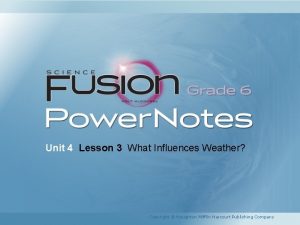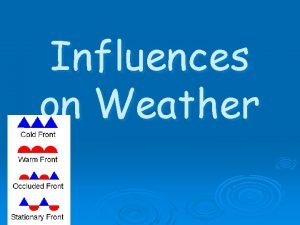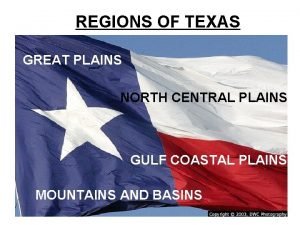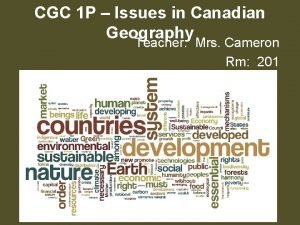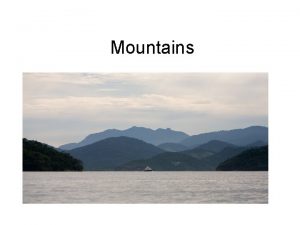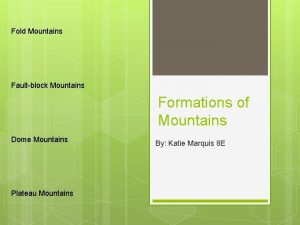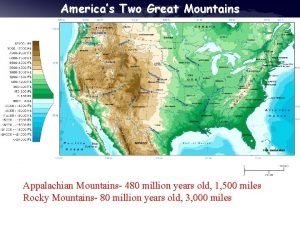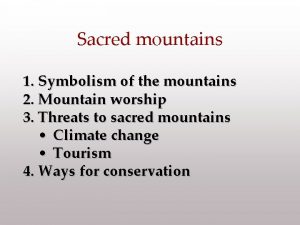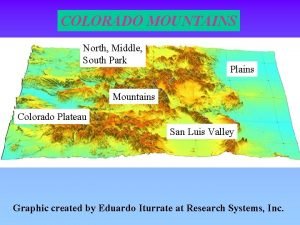Geographical Influences on Weather EQ How do mountains















- Slides: 15

Geographical Influences on Weather

EQ: How do mountains, large bodies of water and wind affect climate and weather?

Mountains Ø Temperature of mountainous areas Rain shadow effect (video 1: 15) Ø http: //www. teachertube. com/view. Video. php? video_id=20 0048 Ø

Bodies of Water Ø Water temperatures change more slowly than land temperatures. Ø This means areas near large bodies of water will have milder temperatures since the water helps regulate the land temperatures. Ø Land near large bodies of water will also get more snowfall because of the moisture in the air (from the nearby water)

Breezes and Winds Ø Breezes and winds are also affected by temperature and bodies of water. Ø Some different types of breezes are: l sea l land l mountain l valley

Sea Breeze Ø Along the coast, land sea are heating differently. This leads to the development of local winds called sea breezes. Ø As air above the land surface is heated by radiation from the Sun, it expands and begins to rise, being lighter than the surrounding air. Ø To replace the rising air, cooler air is drawn in from above the surface of the sea. This is how a sea breeze is formed.


Land Breeze Ø A land breeze occurs at night when the land cools faster than the sea. Ø The air above the water is warmer than the land so it rises, creating a low pressure area. Ø The air above the land is cooler (a high pressure area) so it flows towards the water, into the low pressure area, creating a land breeze.

Land Breeze


Valley Breeze Ø During the day, the surface of the mountain heats the air high up in the atmosphere, quicker than the valley floor can. Ø As the warmer air expands a low pressure area is created near the top of the mountain. The valley is a high pressure area, so, that air flows toward the low pressure area, creating a breeze that blows from the valley floor up towards the top of the mountain.

Mountain Breeze Ø In the evening, the mountain slopes cool the surrounding air more quickly than the air found lower in the atmosphere like in the valley. Ø The high pressure area of the cooler mountain tops blows down the mountain towards the low pressure area of the warmer valley.

Valley and Mountain Breezes When the valley floor warms during the day, warm air rises up the slopes of surrounding mountains and hills to create a valley breeze. At night, denser cool air slides down the slopes to settle in the valley, producing a mountain breeze.

Read and Think Read with a partner about the geographical influences on weather and climate (pages 113115 in the EOG Science Book Ø Discuss with your partner Ø On your own, answer questions 1 -4 on page 116. Ø

sources Ø http: //www. kidsgeo. com/geography-for- kids/0084 -pressure-and-density. php Ø http: //www. britannica. com
 What influences weather
What influences weather What influences the weather
What influences the weather Mountains and basins
Mountains and basins Weather and clothes
Weather and clothes Capital weather gang weather wall
Capital weather gang weather wall Sunny rainy cloudy windy stormy
Sunny rainy cloudy windy stormy Weather station model practice
Weather station model practice Whether the weather is fine
Whether the weather is fine Whether the weather be fine
Whether the weather be fine Heavy weather by weather report
Heavy weather by weather report Canada geographical location
Canada geographical location Geographic events
Geographic events Registration process of geographical indication
Registration process of geographical indication Geographic isolation
Geographic isolation Test articles with geographical names
Test articles with geographical names Roman architecture influence
Roman architecture influence
